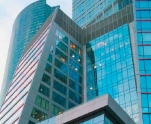Power Efficiency of High-Rise Buildings

In mind of a “regular” citizen of our country the word “skyscraper” and the notion of “energy efficiency”, as a rule, have nothing in common. Moreover, some citizens having special concern of “saving” Russia from the collapse of the power resources and advocate for energy savings are proponents of freezing the erection of not only high-rise, but simply unique buildings with large glazing area.
One of the purposes of this article, and, definitely, of our work - to lift the veil of incompetence in this matter. Impossible to hide the fact that current methods of assessing heat loss (and actually energy efficiency) used in our country, are imperfect and need serious improvement. To put it more precisely, for ordinary buildings with low-glazing area as it regulated by SNiP 23-02-2003 (not more than 18% for residential and 25% for public buildings), the present method works quite well with acceptable accuracy.
But once the issue concerns really structurally complicated building projects, the error happens truly gigantic. By chance In our hands was fallen 4 different edition of the “energy performance certificate” for the same high-rise building, designed by various organizations.
Surprisingly, but the change of given heat transfer resistance from 0.56 m20S/Vt to 0.67 m20S/Vt led to “increase” of the specific heat loss for 15.6% ... Of course, the reason was not in violation of the laws of physics, but in the level of competence and qualification of the experts who prepared the energy performance certificate, accounting for all the required parameters. Thus, in analyzing the mentioned energy passports managed to find out that a simple rounding off up to 3 significant figures in the processing data program causes an error for tens of thousands of kilowatts in the specific heat loss from buildings.
Another argument in favor of highly glazed buildings can be rapid progress in the field of manufacturing energyefficient windows. Perhaps the only area of construction, where nanotechnology is really applied is the plating with so-called energy-saving coatings. If ten years ago, the emission factor of 0.07 (the ratio of incident energy to passing through the glass, i.e., the actual rate of heat loss of the building) was perhaps almost the most optimal, in the process of development of the industry this ratio decreased to 0.05, 0.03, and now attainable value already of 0.01.
At the same time this low-emissivity coating is to be quenched, and act as sun protection, becoming multifunctional. At the same time this lowemissivity coating is to be quenched, and act as sun protection, becoming multifunctional. Unfortunately, the program for the construction of tall buildings, "High- Rise Ring of Moscow" is currently suspended. We won’t argue with the architects of a new architectural image of our cities - it’s more of their competence.
However, the construction of tall buildings always indicative of the power and the economic stability of the state and the suspension of such projects depict the instability and uncertainty about the future.
Full version you can download here
 Text by ALEXEY VERKHOVSKY, PhD . tech. Sciences,
Text by ALEXEY VERKHOVSKY, PhD . tech. Sciences,
Head of Laboratory of “Protecting designs (enclosing structures) of high-rise and unique buildings” Scientific-Research Institute of Construction Physics (NIISF ) RAABS;
jun. scientist IGOR NANASOV of Scientific-Research Institute of Construction Physics (NIISF) RAABS
and ANDREY SHEKHOVTSOV research associate scientist of Scientific-Research Institute of
Construction Physics (NIISF) RAABS


